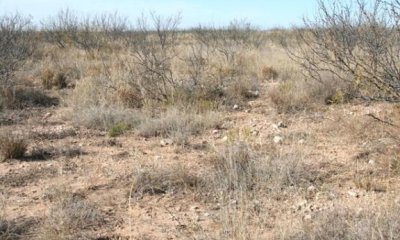
Shallow 12-17" PZ
Scenario model
Current ecosystem state
Select a state
Management practices/drivers
Select a transition or restoration pathway
-
Transition T1A
Absence of disturbance and natural regeneration over time, may be coupled with excessive grazing pressure
More details -
Transition T1B
Absence of disturbance, natural regeneration over time and introduction of non-natives, coupled with excessive grazing pressure
More details -
Restoration pathway R2A
Adequate rest from defoliation and removal of woody canopy, followed by reintroduction of historic disturbance regimes
More details -
Restoration pathway R3A
Adequate rest from defoliation and removal of woody canopy and non-native species, followed by reintroduction of historic disturbance regimes
More details -
No transition or restoration pathway between the selected states has been described
Target ecosystem state
Select a state
State 1
Grassland State



Description
The Reference Plant Community of the Shallow Ecological Site is a Shortgrass/Midgrass Community (1.1). Few if any tallgrass species can be found. Grass species account for 90 percent of the total site production. A wide variety of forbs are produced on this site with scattered woody shrubs equally accounting for 10 percent of the total annual production. The dominant shortgrass species was black grama, with lesser amounts of buffalograss and Wright threeawn.
With continuous heavy grazing, no fire, no brush management and/or pest management this site will transition to the Shortgrass/Shrub/Annuals Community (1.2). As livestock and wildlife numbers increase and grazing use exceeds a plants ability to sustain defoliation, the more palatable and generally more productive species decline in stature, productivity and density. The tendency of this site is to become a shortgrass dominant site if long-term grazing abuse occurs. This will lead to a decline in the vigor of sideoats grama and other palatable midgrass species.
Submodel
Description
If long-term, heavy grazing continues with no fire or any form of brush and pest management, a major threshold will be crossed from the Grassland State (1.0) to the Shrubland State (2.0). In this state, mesquite, broom snakeweed and pricklypear will dominate the site. The typical shortgrass species will be perennial three-awns, hairy tridens and other invading low quality short grasses. Bare areas will increase with annuals filling the voids.
Submodel
Description
Lehman lovegrass is the dominant grass species with few if any native species remaining. The resulting plant community is a Lehman Lovegrass/Shrub Dominant Community (3.1). Once this lovegrass has become well established, returning the site to the reference state(1)would be expensive and generally not very successful or practical.
Submodel
Mechanism
If long-term, heavy grazing continues with no fire or any form of brush and pest management, a major threshold will be crossed from the Shortgrass/Shrubs/Annuals Community (1.2) to the Shrub/Shortgrass Community (2.1). In this state, mesquite, broom snakeweed and pricklypear will dominate the site.
Mechanism
If long-term, heavy grazing continues with no fire or any form of brush and pest management, along with encroachment of introduced grasses such as Lehman lovegrass, a major threshold will be crossed from the Shortgrass/Shrubs/Annuals Community (1.2) to the Lehman lovegrass/ Shrubs Community. Dominant species include Lehman lovegrass and mesquite.
Mechanism
The plant community is so degraded that it cannot reverse retrogression without extensive energy and management inputs. Prescribed grazing with rest periods during the growing season, re-seeding with adapted native grass species, chemical and/or mechanical brush management, and some form of pest management will be required to return this state back to the reference state(1). With the reduced amounts of grass fuel, prescribed burning is usually not an option in this state.
Relevant conservation practices
| Practice | External resources |
|---|---|
|
Brush Management |
|
|
Range Planting |
|
|
Integrated Pest Management (IPM) |
|
|
Prescribed Grazing |
Mechanism
Returning the site to the reference state would be expensive and generally not very successful or practical. Prescribed burning for seedbed preparation purposes may be necessary to remove excessive amounts of plant biomass. Moderate to heavy mechanical brush management, heavy seedbed preparation and re-seeding to a native grass mixture would be required.
Relevant conservation practices
| Practice | External resources |
|---|---|
|
Brush Management |
|
|
Prescribed Burning |
|
|
Range Planting |
|
|
Prescribed Grazing |
Model keys
Briefcase
Add ecological sites and Major Land Resource Areas to your briefcase by clicking on the briefcase (![]() ) icon wherever it occurs. Drag and drop items to reorder. Cookies are used to store briefcase items between browsing sessions. Because of this, the number of items that can be added to your briefcase is limited, and briefcase items added on one device and browser cannot be accessed from another device or browser. Users who do not wish to place cookies on their devices should not use the briefcase tool. Briefcase cookies serve no other purpose than described here and are deleted whenever browsing history is cleared.
) icon wherever it occurs. Drag and drop items to reorder. Cookies are used to store briefcase items between browsing sessions. Because of this, the number of items that can be added to your briefcase is limited, and briefcase items added on one device and browser cannot be accessed from another device or browser. Users who do not wish to place cookies on their devices should not use the briefcase tool. Briefcase cookies serve no other purpose than described here and are deleted whenever browsing history is cleared.
Ecological sites
Major Land Resource Areas
The Ecosystem Dynamics Interpretive Tool is an information system framework developed by the USDA-ARS Jornada Experimental Range, USDA Natural Resources Conservation Service, and New Mexico State University.




